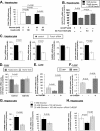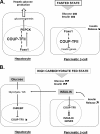The transcription factor COUP-TFII is negatively regulated by insulin and glucose via Foxo1- and ChREBP-controlled pathways
- PMID: 18765640
- PMCID: PMC2573225
- DOI: 10.1128/MCB.02211-07
The transcription factor COUP-TFII is negatively regulated by insulin and glucose via Foxo1- and ChREBP-controlled pathways
Abstract
COUP-TFII has an important role in regulating metabolism in vivo. We showed this previously by deleting COUP-TFII from pancreatic beta cells in heterozygous mutant mice, which led to abnormal insulin secretion. Here, we report that COUP-TFII expression is reduced in the pancreas and liver of mice refed with a carbohydrate-rich diet and in the pancreas and liver of hyperinsulinemic and hyperglycemic mice. In pancreatic beta cells, COUP-TFII gene expression is repressed by secreted insulin in response to glucose through Foxo1 signaling. Ex vivo COUP-TFII reduces insulin production and secretion. Our results suggest that beta cell insulin secretion is under the control of an autocrine positive feedback loop by alleviating COUP-TFII repression. In hepatocytes, both insulin, through Foxo1, and high glucose concentrations repress COUP-TFII expression. We demonstrate that this negative glucose effect involves ChREBP expression. We propose that COUP-TFII acts in a coordinate fashion to control insulin secretion and glucose metabolism.
Figures







References
-
- Aspinwall, C., J. Lakey, and R. Kennedy. 1999. Insulin-stimulated insulin secretion in single pancreatic beta cells. J. Biol. Chem. 2746360-6365. - PubMed
-
- Bardoux, P., P. Zhang, D. Flamez, A. Perilhou, T. Lavin, J. Tanti, K. Hellemans, E. Gomas, C. Godard, F. Andreelli, M. Buccheri, A. Kahn, Y. Le Marchand-Brustel, R. Burcelin, F. Schuit, and M. Vasseur-Cognet. 2005. Essential role of chicken ovalbumin upstream promoter-transcription factor II in insulin secretion and insulin sensitivity revealed by conditional gene knockout. Diabetes 541357-1363. - PubMed
-
- Benoit, G., A. Cooney, V. Giguere, H. Ingraham, M. Lazar, G. Muscat, T. Perlmann, J. P. Renaud, J. Schwabe, F. Sladek, M. J. Tsai, and V. Laudet. 2006. International Union of Pharmacology. LXVI. Orphan nuclear receptors. Pharmacol. Rev. 58798-836. - PubMed
-
- De Martino, M., S. Alesci, P. Chrousos, and T. Kino. 2004. Interaction of the glucocorticoid receptor and the chicken ovalbumin upstream promoter-transcription factor II (COUP-TFII): implications for the actions of glucocorticoids on glucose, lipoprotein, and xenobiotic metabolism. Ann. N. Y. Acad. Sci. 102472-85. - PubMed
Publication types
MeSH terms
Substances
LinkOut - more resources
Full Text Sources
Medical
Molecular Biology Databases
Research Materials
Miscellaneous
